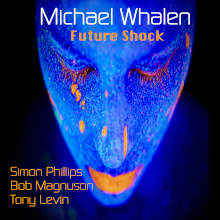The Graham Album Review #2077

Click on CD Cover for Audio Review in streaming mp3 format | |
Michael Whalen: Future Shock
by George Graham
(Independent release, as broadcast on WVIA-FM 5/26/2021)

Click on CD Cover for Audio Review in streaming mp3 format | |
Michael Whalen: Future Shock
by George Graham
(Independent release, as broadcast on WVIA-FM 5/26/2021)
Electric instrumental music can range widely, running from surf guitar twang, to metal guitar shredding, to rock jam bands, to jazz-rock fusion to electronic. While there is some overlap, most of these sub-genres have stayed fairly distinct. This week we have an interesting album that is a kind of hybrid of the electric jazz-rock fusion that arose in the 1970s, and synthesizer based electronic. It’s the new recording by Michael Whalen called Future Shock.
Michael Whalen is a prolific synthesist and composer who has created the scores for many a film and TV production, including for PBS shows, and winning two Emmy Awards in the process. He has served as a producer for over 100 recordings by others. In 2020, he released an album of, what I suppose could be called “traditional” electronic music called called Sacred Spaces, which we featured on this album review series. The all-solo album was created entirely with synthesizers with a generally atmospheric sound, along the lines of New Age music.
Now Whalen has taken a different direction on Future Shock, working with a band and creating music on the electric end of the jazz-rock fusion spectrum. His notable collaborators from the rock and fusion field, are drummer Simon Phillips who as worked with everyone from the Who and Judas Priest to Toto; and bassist Tony Levin, known for his work with King Crimson; along with jazz saxophonist Bob Magnuson. There is no guitarist in the group, instead Whalen wails with his synthesizers, evoking the sound of pioneering fusion bands like Return to Forever, and Jan Hammer with the Mahavishnu Orchestra. But the album can tend toward the melodic at times, evoking the smooth jazz scene. It’s sometimes an interesting juxtaposition with new agey synthesizers mixing with 1970s influenced fusion. The result makes for often energetic music, though sometimes I think Whalen and company could have dialed it back at bit. But the compositions are generally interesting and well-structured, and do cover a fairly wide range making for interesting listening.
Opening is the title piece Future Shock, which sets up the stylistic amalgam that characterizes the album, with an electronic introduction leading into the very electric band section. <<>>
Hop, Skip and Jump is more toward electric fusion, with Whalen’s synthesizer taking the part of the blazing electric guitar. <<>> Magnuson’s tenor sax solo evokes soul or funk. <<>>
One of the jazzier sounding tracks on the album is La Hermosa Noche with a Latin beat and Magnuson soloing on flute. <<>>
On the other hand, the more atmospheric electronic side is spotlighted on Lights of Home with Magnuson getting appropriately ethereal. <<>>
A track called Poly Jam is rather well-named with its energetic hybrid of the jazz-rock fusion aspect with the spacey synthesizer. <<>>
The album also ventures into smooth jazz territory with the track Morning Song which is not its most imaginative moment. <<>>
The album’s most unrelentingly electric track is Wanderlust with Whalen simulating guitar shredding on his synth. But the tune’s freneticism seems a bit contrived. It can be a little exhausting to listen to. <<>>
The album ends with Your Eyes, Your Touch, Your Kiss, one of the album’s most interesting tracks, with the stylistic hybrid being especially effective in combining the electronics with the fusion, with a little soul thrown in, thanks to Bob Magnuson’s tenor sax solo. <<>>
Future Shock, the new album from long time sythesist and composer Michael Whalen is a departure from his previous all electronic music album. This one, with a regular band, still relies on Whalen’s electronic keyboards for the core of the sound, but having the drummer who replaced Keith Moon in the Who, and King Crimson’s bassist definitely adds an edge to the music. Bob Magnuson is a versatile saxophonist who plays multiple instruments on the album, and goes from soul influenced to high-energy fusion to the lighter weight of the smooth jazz scene. The result is a worthwhile album that represents a distinctive stylistic mix, though sometimes the music can seem a bit too cranked up.
Our grade for sound quality is about a B-plus. Part of the often aggressive sound of the album comes from the recording process and the overuse of volume compression to make everything loud all the time. A bit more dynamics would have made for a more engaging listening experience.
Combining electronic music with energetic jazz-rock fusion has not often been done in this way very much in the past. Usually a guitar player is in the spotlight. There’s no guitar on Michael Whalen’s new album, but the dominance of the synthesizers in the electric context makes for some creative sounds.
(c) Copyright 2021 George D. Graham. All rights reserved.
This review may not be copied to another Web site without written permission.
 To Index of Album Reviews | To George Graham's Home Page. | What's New on This Site.
To Index of Album Reviews | To George Graham's Home Page. | What's New on This Site.